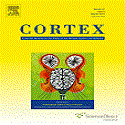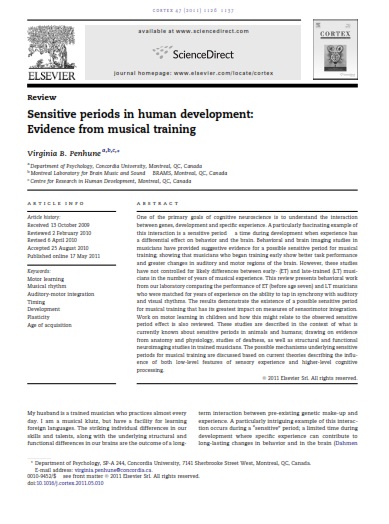ترجمه فارسی مقاله:
دوره های حساس در رشد انسان:با شواهدی از آموزش موسیقی
مشخصات و منبع مقاله
مشخصات و منبع مقاله
- منبع مقاله: سایت
 Science Direct
Science Direct - نشریه: Cortex
- سال انتشار: ۲۰۱۱
- موضوع: تربیت بدنی رفتارحرکتی،رشد حرکتی
- تعدادصفحات انگلیسی:۱۲
- تعداد صفحات فارسی ترجمه شده: ۲۳
- فایل بصورت: Word قابل ویرایش
- قیمت بر حسب تومان : ۱۵,۰۰۰ هزارتومان
عنوان انگلیسی مقاله:
Sensitive periods in human development: Evidence from musical training
نویسندگان:
Virginia B. Penhune
چکیده انگلیسی مقاله:
Abstract
One of the primary goals of cognitive neuroscience is to understand the interaction between genes, development and specific experience. A particularly fascinating example of this interaction is a sensitive period e a time during development when experience has a differential effect on behavior and the brain. Behavioral and brain imaging studies in musicians have provided suggestive evidence for a possible sensitive period for musical training; showing that musicians who began training early show better task performance and greater changes in auditory and motor regions of the brain. However, these studies have not controlled for likely differences between early- (ET) and late-trained (LT) musicians in the number of years of musical experience. This review presents behavioral work from our laboratory comparing the performance of ET (before age seven) and LT musicians who were matched for years of experience on the ability to tap in synchrony with auditory and visual rhythms. The results demonstrate the existence of a possible sensitive period for musical training that has its greatest impact on measures of sensorimotor integration. Work on motor learning in children and how this might relate to the observed sensitive period effect is also reviewed. These studies are described in the context of what is currently known about sensitive periods in animals and humans; drawing on evidence from anatomy and physiology, studies of deafness, as well as structural and functional neuroimaging studies in trained musicians. The possible mechanisms underlying sensitive periods for musical training are discussed based on current theories describing the influence of both low-level features of sensory experience and higher-level cognitive processing
وازگان کلیدی
وازگان کلیدی
Motor learning, Musical rhythm-Auditory ,motor integration, Timing Development, Plasticity ,Age of acquisition
ترجمه فارسی چکیده مقاله:
یکی از اهداف اولیه علوم اعصاب شناختی پی بردن و شناخت تعامل بین ژن ها، رشد و تجربه خاص است. یک مثال جالب از این تعامل “یک دوره حساس” است ، دوره ی زمانی که در حین رشد ، یک تجربه ،یک اثر متفاوتی بر رفتار و مغز دارد.
مطالعات تصویربرداری رفتاری و مغزی در نوازندگان ، شواهد مطرحی بر یک دوره حساس بالقوه از طریق آموزش موسیقی ارائه کرده اند؛ که در آن نشان می دهد نوازندگانی که در سنین پایین آموزش را آغاز کرده اند در تکلیف مربوطه عملکرد بهتری داشته اند و در مناطق شنوایی و حرکتی مغزتغییرات بیشتری داشته اند. با این حال، این مطالعات تفاوت محتمل بین نوازندگان با تعلیم زودهنگام (LT) و نوازندگان با تعلیم دیر هنگام (ET) از نظر تعداد سالهای تجربه موسیقی را کنترل و بررسی نکرده اند. این بررسی مطالعه رفتاری صورت گرفته در آزمایشگاه را با مقایسه عملکرد نوازندگان با تعلیم زود هنگام (قبل از سن هفت سالگی ) و نوازندگان با تعلیم دیر هنگام که از لحاظ سالهای تجربه در توانایی ضرب هماهنگ با ریتم دیداری و شنیداری در گروه های همسان و برابرقرارداده شدند، ارائه می کند. نتایج وجود یک دوره حساس بالقوه از طریق آموزش موسیقی که بزرگترین تاثیر آن بر میزان یکپارچگی حسی و حرکتی است ، را نشان می دهد. پژوهش بر روی یادگیری حرکتی در کودکان و چگونه این امر می تواند به اثر دوره حساس مشاهده شده مرتبط باشد نیز بررسی می شود. این مطالعات در زمینه آنچه که در حال حاضر در مورد دوره های حساس در حیوانات و انسان شناخته شده را توصیف می نماید . که این امر با آوردن شواهدی از آناتومی و فیزیولوژی، مطالعات ناشنوایی، و همچنین بررسی های تصویربرداری ساختاری و عملکردی در نوازندگان آموزش دیده حاصل می شود. مکانیسم های احتمالی مبنای “دوره های حساس ” از طریق آموزش موسیقی بر اساس نظریه های فعلی بحث می شود نظریه ها یی که در آن تاثیر هر دو ویژگی های سطح پایین تجربه حسی و پردازش شناختی در سطح بالاتر است.
کلیدواژه:
یادگیری حرکتی ، ریتم موسیقی -شنوایی- یکپارچگی حرکتی- زمان بندی ، رشد -پلاستیسیته-سن اکتساب یا فراگیری
برای دانلود ترجمه کامل و دقیق مقاله از طریق زیر اقدام کنید.
دانلود صفحه اول برای تایید استاد :کلیک کنید
دانلود صفحه اول برای تایید استاد :کلیک کنید

منابع مقاله
منابع مقاله
Amunts K, Schlaug G, Janke L, Steinmetz H, Schleicher A, Dabringhaus A, et al. Motor cortex and hand motor skills: Structural compliance in the human brain. Human Brain Mapping, 5: 206e215, 1997.
Baharloo S, Johnston P, Service S, Gitschier J, and Freimer N. Absolute pitch: An approach for identification of genetic and nongenetic components. American Journal of Human Genetics, 62: 224e231, 1998.
Bailey J and Penhune V. Rhythm synchronization performance and auditory working memory in early- and late-trained musicians. Experimental Brain Research, 204: 91e101, 2010.
Barnea-Goraly N, Menon V, Eckert M, Tamm L, Bammer R, Karchemskiy, et al. White matter development during childhood and adolescence: A cross-sectional diffusion tensor imaging study. Cerebral Cortex, 15: 1848e1854, 2005.
Beitel R, Schreiner C, Cheung S, Wang X, and Merzenich M. Reward-dependent plasticity in the primary auditory cortex of adult monkeys trained to discriminate temporally modulated signals. Proceedings of the National Academy of Sciences of the USA, 100: 11070e11075, 2003.
Bengtsson S, Nagy Z, Skare S, Forsman L, Forssberg H, and Ulle ´ nF. Extensive piano practicing has regionally specific effects on white matter development. Nature Neuroscience,8: 1148e1150, 2005.
Bermudez P, Lerch J, Evans A, and Zatorre R. Neuroanatomical correlates of musicianship as revealed by cortical thickness and voxel-based morphometry. Cerebral Cortex, 19: 583e596, 2009.
Besson M, Scho ¨ n D, Moreno S, Santos A, and Magne C. Influence of musical expertise and musical training on pitch processing in music and language. Restorative Neurology and Neuroscience, 25: 399e410, 2007.
Bischof H-J. Behavioral and neuronal aspects of developmental sensitive periods. NeuroReport, 18: 461e465, 2007. Blake D, Heiser M, Caywood M, and Merzenich M. Experiencedependent adult cortical plasticity requires cognitive association between sensation and reward. Neuron, 52: 371e381, 2006.
Blood A and Zatorre R. Intensely pleasurable responses to music correlate with activity in brain regions implicated in reward and emotion. Proceedings of the National Academy of Sciences of the USA, 98: 11818e11823, 2001.



